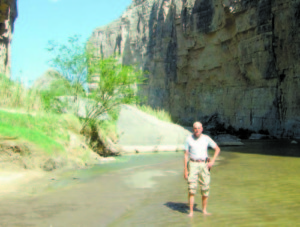On my Corner
By Bob Casimiro
My recent trip to the southwest was as much about the weather as my participation in border watch activities with the all-volunteer members of Arizona Border Recon. While the purpose of the trip was a weeklong exercise on the southern border, the weather was, with one notable exception, uncommonly cold and a continuing and annoying factor during my month long trip.
When I left New England last month it was through a snow squall in New Hampshire and my return was similar, as I went through snow squalls in Ohio and 40-degree temperatures there and back in Maine. On my previous nine trips I could expect rain going through Pennsylvania and, upon reaching Oklahoma and beyond, sunshine and moderate temperatures the rest of the way (I record temperatures inside and outside my tent, so I was acutely aware of the unseasonable weather).
The most surprising was the cold right at the border. It normally gets down to a low of 40 to 45 degrees overnight but, one day when I got out of my tent, it was 32 degrees Fahrenheit.
This made it especially difficult for those who went on overnight assignments into the mountains. It is bad enough under normal conditions, but this year we were at a new location, further west and in south central Arizona near the town of Ruby (population around 1,200), and just a few miles from the border. This is a mountainous region, further out into the desert than previous exercises, which makes it more attractive for the drug cartel to push drugs and human contraband across the border. But the remoteness, the mountains, and the cold was a strain for everyone, especially on night exercises requiring climbing steep mountains, made especially difficult by the preponderance of loose rock.
Tim Foley, the field director who has lived here and conducted field exercises since 2010, recommends those coming for these encampments to prepare by drinking two gallons of water a day and taking magnesium and potassium supplements. One guy was exhausted and had to have an IV administered by a New York EMS who was part of the group.
My assignment was limited to a daytime observation post, along with two female members of our immigration group. There was another female in camp, a naturalized U.S. citizen originally from El Salvador, who was able to make it to the top of the mountain, quite an achievement.
Things took a decided turn, climate-wise, the following week after the completion of our weeklong exercise, when I spent two days in Big Bend National Park in Texas. The temperature on the day I arrived: 105 degrees Fahrenheit — from freezing to boiling.
And then back to the freezer.
On my way back, I camped at Lake Wappapello, Mo. It was 40 degrees and the park was deserted, except for me and the Camp Host, who took my $8 fee and went back to his large-screen TV. After a fitful five hours of sleep, I got up at 2:30 a.m. to break camp and be on my way, with the temperature at 35 degrees Fahrenheit. It took an hour more than normal as I had to retreat to the warmth of my idling truck every 10 minutes to warm my numb fingers.
Camping is an economic necessity as well as an opportunity to enjoy the outdoors. I can’t afford $70 to $140 nights in hotels/motels. State parks are generally the best value, and even better are “primitive†sites. There is one in Kentucky I stayed at that is $5 a night. The best “deal,†though, is Buenos Aires National Wildlife Refuge in Sasabee, Ariz.: no charge, and the view from site #63 is spectacular. Of course, there are no “facilities†but a shovel and a little digging will take care of that.
Watch out for the cactus.



